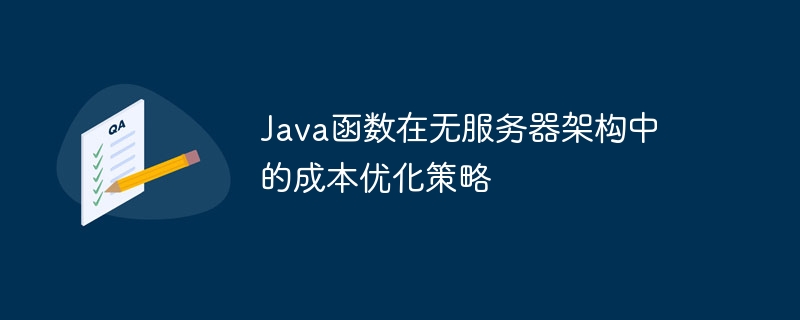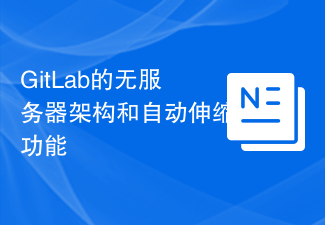You can optimize the cost of Java functions in a serverless architecture by adopting the following strategies: Reserve memory and avoid cold start costs. Adjust the minimum number of instances to optimize cost. Choose the right pricing plan and pay for what you use. Optimize code to reduce execution time and reduce CPU usage. Leverage autoscaling to automatically adjust the number of instances based on load.

Cost Optimization Strategy for Java Functions in Serverless Architecture
Introduction
In Serverless Architecture Server architecture dynamically allocates and deallocates resources on demand based on usage, making it ideal for cost optimization. This article explores cost optimization strategies for Java functions to help you minimize the cost of serverless functions.
Strategy 1: Use reserved memory
Reserved memory allows you to allocate a specific amount of memory to functions even if they are inactive. This eliminates the cost of reallocating memory each time the function starts, thereby reducing startup latency and cold start costs.
Code Example:
FunctionsFramework.http("helloGet", (httpRequest, httpResponse) -> {
// 函数逻辑
});
.setMemory("128MB") // 预留 128MB 内存
.setMinInstances(2); // 预留 2 个最小实例Strategy 2: Adjust the Minimum Number of Instances
The minimum number of instances specifies the function to run at any given time Number of instances. Increasing or decreasing this number can optimize costs.
Code sample:
FunctionsFramework.http("helloGet", (httpRequest, httpResponse) -> {
// 函数逻辑
});
.setMinInstances(0); // 取消预留最小实例Strategy 3: Choose the right pricing plan
Google Cloud Functions offers flexible pricing plans, including per Call billing, time-of-use billing, and other usage-based options. Choosing the best option based on your usage patterns is crucial.
Code example:
functions.cloud.google.com/pricing-plan: "FLEXIBLE" // 设置定价方案
Strategy 4: Reduce execution time
Function execution time is an important factor in cost. Optimizing code to reduce execution time can save costs by reducing CPU usage and improving efficiency.
Code Example:
public class ExampleFunction {
@Override
public void accept(@Nullable PubsubMessage message, @Nullable Context event) {
String text = null;
if (message != null) {
text = StandardCharsets.UTF_8.decode(message.getData()).toString();
}
if (text != null && !text.isEmpty()) {
// 函数逻辑
}
}
}Strategy 5: Leverage Autoscaling
Autoscaling allows a function to automatically adjust its number of instances based on request load. This helps prevent overcommitment during peak traffic times and save costs during slow traffic times.
Code example:
AutomaticScaling scaling = AutomaticScaling.of(1, 5); // 自动缩放范围为 1 到 5
Practical case
The following is a real case that successfully reduced the cost of Java functions using the above strategy:
Application: A Web application that uses Functions to respond to HTTP requests.
Strategy:
- Reserve 256MB of memory
- Set the minimum number of instances to 1
- Select billing by call Solution
- Optimize code to reduce execution time
- Implement automatic scaling
Result:
Total function cost reduced 40% while maintaining application performance and scalability.
The above is the detailed content of Cost optimization strategies for Java functions in serverless architecture. For more information, please follow other related articles on the PHP Chinese website!
 Java函数在无服务器架构中的成本优化策略Apr 28, 2024 am 11:06 AM
Java函数在无服务器架构中的成本优化策略Apr 28, 2024 am 11:06 AM通过采用以下策略,您可以优化Java函数在无服务器架构中的成本:预留内存,避免冷启动成本。调整最小实例数以优化成本。选择合适的定价方案,按需付费。优化代码以减少执行时间,降低CPU使用率。利用自动缩放来根据负载自动调整实例数量。
 PHP如何对接腾讯云函数计算服务实现无服务器架构的函数运行Jul 05, 2023 pm 06:19 PM
PHP如何对接腾讯云函数计算服务实现无服务器架构的函数运行Jul 05, 2023 pm 06:19 PMPHP如何对接腾讯云函数计算服务实现无服务器架构的函数运行随着云计算的快速发展,无服务器架构逐渐成为云开发的热点话题。腾讯云函数计算服务(TencentCloudFunction)是一种典型的无服务器架构的使用方式,它提供了弹性、稳定、按需自动伸缩等特性,帮助开发者将精力放在代码开发和业务逻辑上,而无需关心基础设施的管理。本文将介绍如何使用PHP语言对接
 使用Java函数和无服务器架构实现事件驱动的系统Apr 27, 2024 pm 04:42 PM
使用Java函数和无服务器架构实现事件驱动的系统Apr 27, 2024 pm 04:42 PM利用Java函数和无服务器架构构建事件驱动的系统:使用Java函数:高度可伸缩、易于部署,管理成本低。无服务器架构:按使用付费模式,消除基础设施成本和管理负担。实战案例:创建事件驱动的警报系统,通过Java函数响应SNS主题事件,发送电子邮件警报。
 Java函数在无服务器架构中的安全性考虑Apr 28, 2024 am 10:51 AM
Java函数在无服务器架构中的安全性考虑Apr 28, 2024 am 10:51 AM在无服务器Java函数中实现安全性至关重要,包括:保护环境变量中的敏感数据。使用IAM管理用户访问权限。验证函数输入和输出以防止恶意代码。启用日志记录以监控函数行为。加密数据以确保传输和处理时的安全性。采用措施来防范攻击,例如输入验证和限制资源使用。
 GitLab的无服务器架构和自动伸缩功能Oct 27, 2023 pm 02:06 PM
GitLab的无服务器架构和自动伸缩功能Oct 27, 2023 pm 02:06 PMGitLab的无服务器架构和自动伸缩功能,需要具体代码示例自动化和云计算技术的快速发展已经在软件开发和运维领域产生了革命性的影响。无服务器架构的概念正在变得越来越流行,它可以极大地简化开发者的工作流程,并且实现更好的资源利用和伸缩性。GitLab作为软件开发和运维平台,也在不断推进无服务器架构的实践和改进。无服务器架构的概念是指开发者不再需要关心服务器的运维
 Java函数在无服务器架构中与缓存服务的集成Apr 27, 2024 am 10:30 AM
Java函数在无服务器架构中与缓存服务的集成Apr 27, 2024 am 10:30 AM在无服务器Java函数中集成缓存服务可提高性能和响应时间,方法是减少函数从慢速数据源获取数据的次数。具体步骤如下:从缓存中获取值。如果值不存在,则从数据库中查询并将其插入到缓存中。
 Java函数如何在企业中支持无服务器架构?Apr 23, 2024 pm 02:00 PM
Java函数如何在企业中支持无服务器架构?Apr 23, 2024 pm 02:00 PMJava函数支持企业中的无服务器架构,提供可扩展性、按需定价和高可用性。实战案例:一个基于Java函数的轻量级数据处理系统,通过按需运行来高效处理大量数据,降低了IT维护成本。
 Java函数在无服务器架构中的调试和故障排除Apr 27, 2024 am 09:54 AM
Java函数在无服务器架构中的调试和故障排除Apr 27, 2024 am 09:54 AM在无服务器架构中调试Java函数需要使用日志记录、指标、IDE调试以及无服务器平台提供的工具。日志记录和指标用于输出错误消息并提供性能洞察。IDE(例如IntelliJIDEA和VisualStudioCode)支持远程调试,提供交互式体验。无服务器平台(例如AWSLambda和AzureFunctions)具有内置工具(如CloudWatchLogs、X-Ray、ApplicationInsights和AzureMonitor)用于跟踪、错误和性能数据。


Hot AI Tools

Undresser.AI Undress
AI-powered app for creating realistic nude photos

AI Clothes Remover
Online AI tool for removing clothes from photos.

Undress AI Tool
Undress images for free

Clothoff.io
AI clothes remover

AI Hentai Generator
Generate AI Hentai for free.

Hot Article

Hot Tools

Atom editor mac version download
The most popular open source editor

Dreamweaver CS6
Visual web development tools

Safe Exam Browser
Safe Exam Browser is a secure browser environment for taking online exams securely. This software turns any computer into a secure workstation. It controls access to any utility and prevents students from using unauthorized resources.

MantisBT
Mantis is an easy-to-deploy web-based defect tracking tool designed to aid in product defect tracking. It requires PHP, MySQL and a web server. Check out our demo and hosting services.

Zend Studio 13.0.1
Powerful PHP integrated development environment






